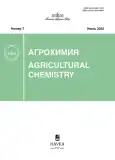INFLUENCE OF DIFFERENT FERTILIZER SYSTEMS ON THE CONSUMPTION OF NUTRIENTS BY THE STANDARD HARVEST OF TABLE CARROTS AND THE ECONOMIC BALANCE OF THESE SUBSTANCES
- 作者: Vasyuchkov I.Y.1, Uspenskaya O.N.1
-
隶属关系:
- The All-Russian Scientific Research Institute of Vegetable Growing – branch of the Federal Scientific Center of Vegetable Growing
- 期: 编号 7 (2025)
- 页面: 58-66
- 栏目: Fertilizers
- URL: https://bakhtiniada.ru/0002-1881/article/view/304316
- DOI: https://doi.org/10.31857/S0002188125070074
- EDN: https://elibrary.ru/suoyhy
- ID: 304316
如何引用文章
详细
The removal of nutrients by table carrots was compared with their amount in the composition of fertilizers applied and the economic balance of these substances was calculated for different carrot fertilizer systems. The study was conducted in 2015–2017 in the Ramenskoye district of the Moscow region (the central floodplain of the Moskva River). The soil of the site is alluvial meadow, medium loamy. The tested crop is carrots of the Losinoostrovskaya 13 variety, fertilizer systems are mineral, organic, and organomineral. Sowing was carried out in the 3rd decade of May, in ridges with a height of 15 cm, with a seeding rate of 900 thousand units/ha, in oneline. During the growing season, 2 row-to-row cultivator treatments and 3–4 manual weeding were carried out. The harvest was recorded in the 3rd decade of September, with the division of products into standard and non-standard fractions. The experimental scheme included the following options: control (without fertilizers) – potential fertility of arable land, N45P30K90 – half the recommended dose, N45P30K90 – half the recommended dose + root dressing in the phase of the beginning of root crop formation (bunch ripeness) based on the results of leaf petiole analysis (on average N20K10), N45P30K90 – half the recommended dose + root dressing in the phase of the beginning of root crop formation (bunch ripeness) based on the results of soil analysis (on average N10K40), N90P60K180 – full recommended dose, biocompost 3 t/ha, N90P60K180 full recommended dose + biocompost 3 t/ha. In an average of 3 years, carrots of the Losinoostrovskaya 13 variety against the background of potential soil fertility produced a standard yield of 46.1 t/ha. The effectiveness of fertilizer systems was as follows: half of the calculated dose of ½ NPK yielded 7.0 t/ha of additional products, ½ NPK + top dressing – 9.8, NPK (full calculated dose) – 6.2, biocompost – 8.7, NPK + biocompost – 12.0 t/ha. A fertilizer dose equal to half of the calculated one was effective enough to obtain an additional crop of standard root crops on this type of soil, and a further increase in the fertilizer dose in the main application could be ineffective. The increase in the yield of standard root crops was achieved mainly due to an increase in the mass of root crops and partly due to an increase in the number of plants with standard root crops. On average, in the experiment, the consumption of basic nutrients for the formation of a standard crop unit was: nitrogen – 15.9, phosphorus – 9.8, potassium – 30.0, calcium – 11.8, magnesium – 4.3 kg/10 t. As the doses of fertilizers increased, the consumption of nutrients per crop unit increased. The complete mineral system (NPK variant) and the organomineral system (NPK + biocompost variant) fully covered the removal of nitrogen, phosphorus and potassium with a standard yield, determining their positive balance, while the organomineral system also fully covered the removal of calcium and, to a large extent – magnesium. With other variations of mineral fertilizer systems, a negative balance of all these nutrients was revealed. In addition, there was a negative balance of calcium and magnesium, which is important to take into account when using the soil for a long time. When using an organic system, with a positive balance of nitrogen, phosphorus and calcium, the potassium balance was negative. Calculation of the coefficients of nutrient utilization (СNU) from mineral and organic fertilizers using the difference method showed that with an increase in the dose of the introduced element, its utilization coefficient, as a rule, decreased. In general, the variations were as follows: СNU N – 18–37, СNU P2O5 – 12–29, СNU K2O – 33–69, СNU CaO – 17–30, СNU MgO – 33–56%.
作者简介
I. Vasyuchkov
The All-Russian Scientific Research Institute of Vegetable Growing – branch of the Federal Scientific Center of Vegetable Growing
Email: vniioh@yandex.ru
俄罗斯联邦,
O. Uspenskaya
The All-Russian Scientific Research Institute of Vegetable Growing – branch of the Federal Scientific Center of Vegetable Growing
编辑信件的主要联系方式.
Email: vniioh@yandex.ru
俄罗斯联邦,
参考
- Солдатенко А.В., Борисов В.А. Экологическое овощеводство. М.: ФНЦО, 2022. 503 с.
- Борисов В.А., Ванеян С.С., Егоров С.С., Ермаков Н.Ф. Пойменное овощеводство. М.: Росагропромиздат, 1991. 223 с.
- Борисов В.А. Система удобрения овощных культур. М.: Росинформагротех, 2016. 392 с.
- Дьяченко В.С. Овощи и их пищевая ценность. М.: Россельхозиздат, 1979. 159 с.
- Вендило Г.Г., Миканаев Т.А., Петриченко В.Н., Скаржинский А.А. Удобрение овощных культур: справ. рук-во. М.: Агропромиздат, 1986. 208 с.
- Муравин Э.А., Титова В.И. Агрохимия (уч. пособ.). М.: КолосС, 2009. 463 с.
- Литвинов С.С. Методика полевого опыта в овощеводстве. М.: РАСХН, ВНИИО, 2011. 648 с.
- Агрохимические методы исследования почв. М.: Наука, 1975. 656 с.
- Минеев В.Г. Практикум по агрохимии. М.: Изд-во МГУ, 2001. 689 с.
- Доспехов Б.А. Методика полевого опыта. М.: Агропромиздат, 1985. 351 с.
- Кораблева Л.И. Плодородие, агрохимические свойства и удобрение пойменных почв Нечерноземной зоны. М.: Наука, 1969. 278 с.
补充文件









